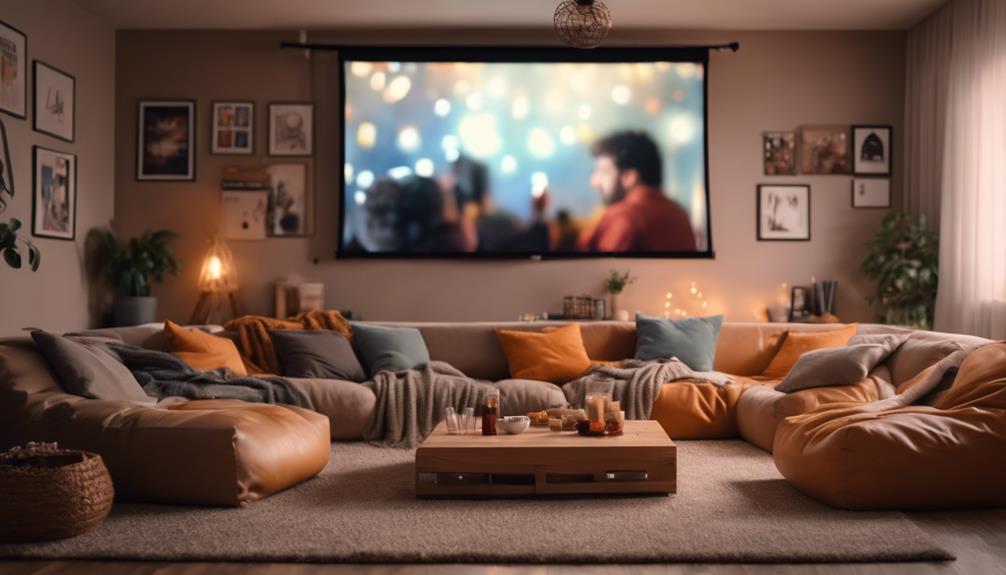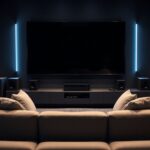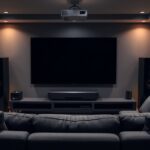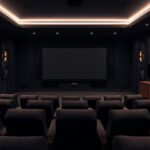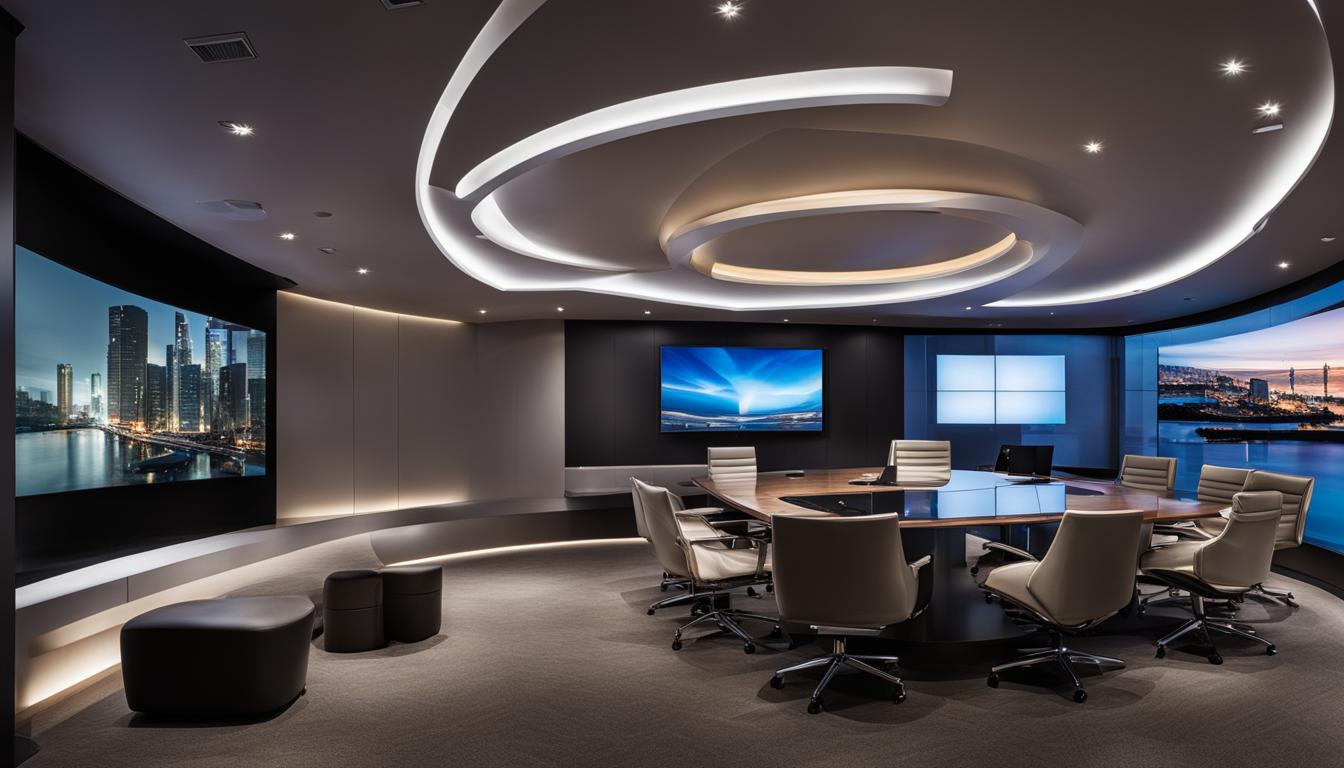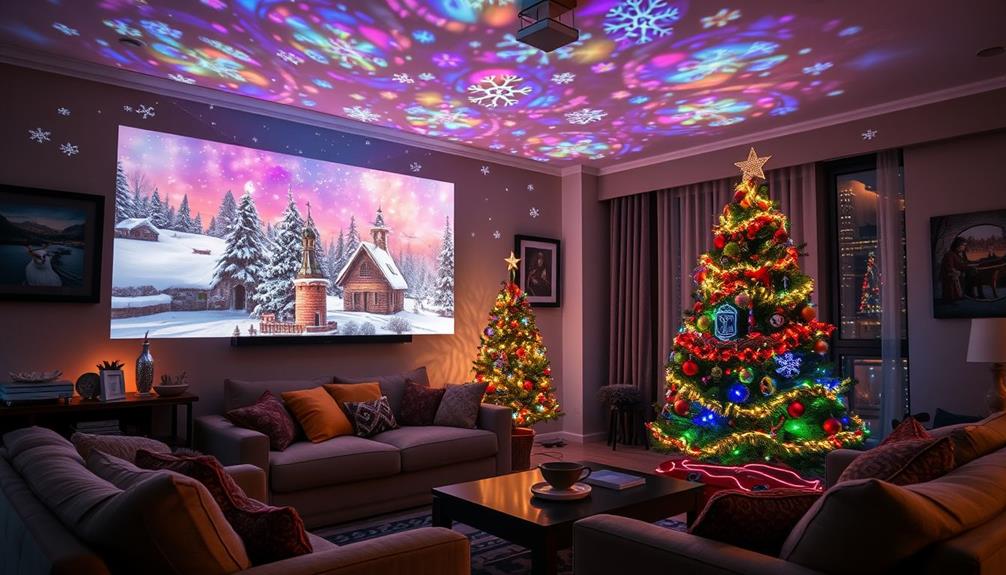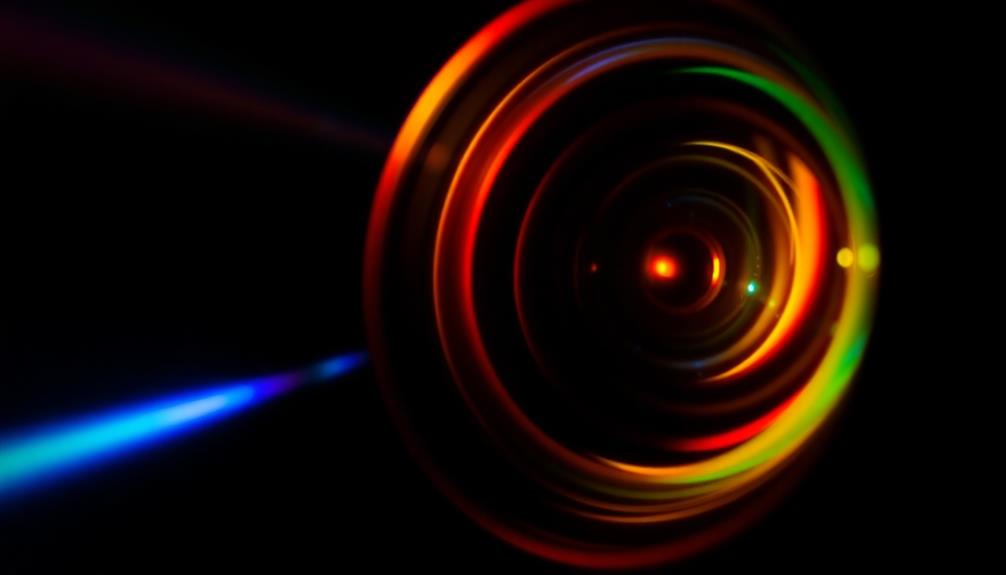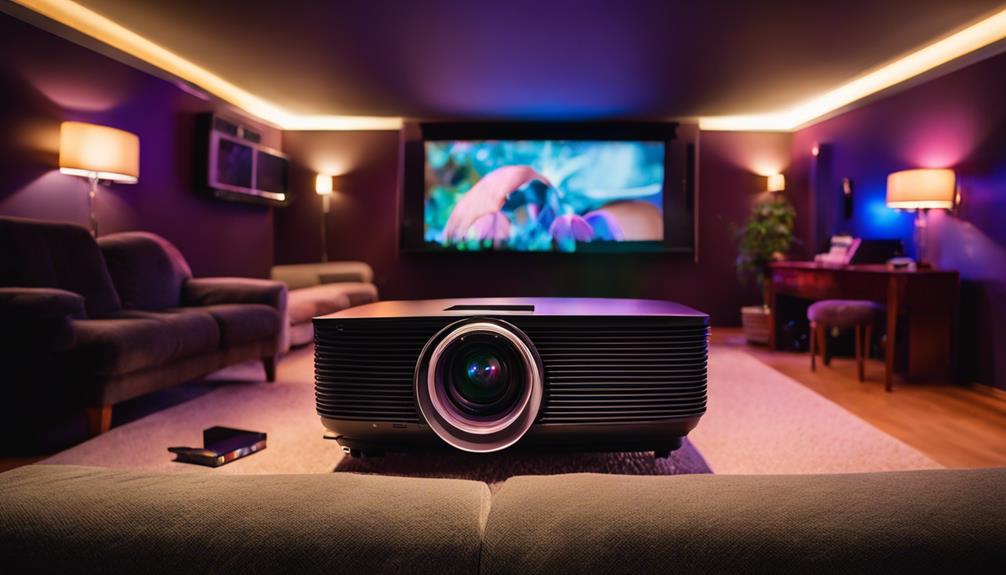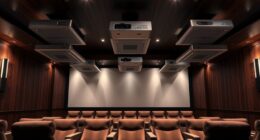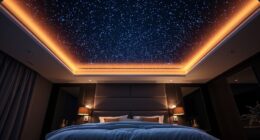You can create a budget-friendly home theater setup by focusing on key components like a quality TV, sound system, and comfortable seating. Start with a 65-inch 4K TV from brands like Hisense or TCL, which offers good value. For audio, consider a soundbar or bookshelf speakers; the TCL Q Class 5.1 sound system is a solid choice. Optimize your room layout by ensuring seating is at the right distance from the screen and adding soft furnishings to enhance acoustics. With smart streaming devices like Amazon Fire Stick, you can access your favorite content easily. There's more to explore on maximizing your setup.
Key Takeaways
- Set a budget of around $1,000, focusing on essentials like a quality TV, sound system, and seating.
- Choose a 65-inch 4K TV from budget-friendly brands like Hisense or TCL for an immersive viewing experience.
- Invest in a modern soundbar or a budget surround sound system to enhance audio quality without overspending.
- Optimize room layout by positioning seating 1.5 to 2.5 times the TV's diagonal size and using soundproofing techniques.
Setting Your Budget Limits
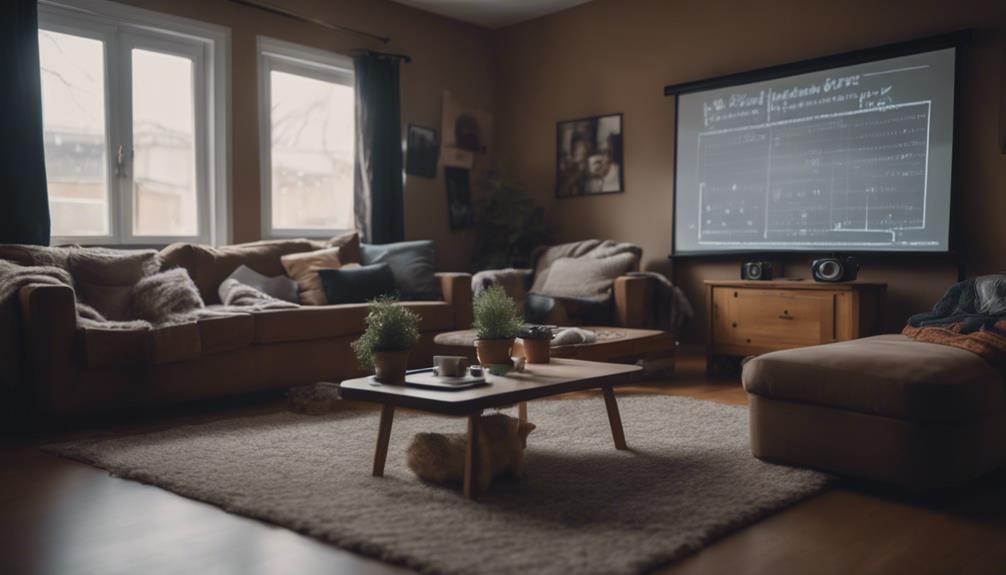
When setting your budget limits for a home theater, it's wise to aim for around $1,000 to cover the essentials without breaking the bank. This way, you can prioritize key items like a quality television and a sound system, guaranteeing a satisfying viewing experience.
Allocate your funds strategically—consider how much you want to spend on each component, and don't forget about seating, which can enhance comfort during movie nights.
To maximize your budget limit, take advantage of discounts and sales. Shopping during holiday sales can lead to significant savings on electronics, so plan your purchases accordingly. It's also a good idea to keep track of all expenses as you go. This will help you avoid overspending and guarantee every purchase aligns with your home theater goals.
Consider incorporating DIY projects for decor and soundproofing. Not only can this save you money, but it can also personalize your space and improve acoustics.
Choosing the Right TV

When you're picking a TV for your budget-friendly home theater, consider the screen size, display technology, and reliable brands.
A 65-inch model can offer an immersive experience without breaking the bank.
Additionally, investing in a quality home theater setup can greatly enhance your viewing pleasure.
Brands like Hisense and Amazon Fire TV provide excellent options that fit your budget while delivering great performance.
Screen Size Considerations
Choosing the right TV size is essential for creating an immersive home theater experience, and a 65-inch screen often strikes the perfect balance for average-sized rooms. This size allows for a fascinating viewing experience without overwhelming your space.
When deciding, keep these key factors in mind:
- Screen Size: A 65-inch screen is ideal for most rooms, providing an immersive experience without being too large.
- 4K Resolution: Opt for a TV with 4K resolution to enjoy sharper images and better details, especially on larger screens.
- Picture Quality: Look for models with a high contrast ratio. Poor picture quality can ruin your enjoyment during darker scenes, so avoid those budget models that compromise on this aspect.
- Built-in Streaming: Choose a TV with built-in streaming platforms. This saves you from buying extra devices and helps you stay within your budget.
Display Technology Options
Several display technology options exist, each offering unique advantages that can enhance your home theater experience on a budget.
When selecting a TV, consider models like the Hisense U6, which is often praised for its impressive picture quality and performance without breaking the bank. Typically, you can find a 65-inch Hisense U6 priced between $450 and $700, making it a smart choice for budget-conscious consumers.
It's important to prioritize picture quality, so steer clear of models with poor contrast. Many of the recommended TVs come with built-in streaming services, allowing you to access your favorite content without needing additional devices. This means you can enjoy seamless streaming from platforms like Netflix and Hulu right out of the box.
If you prefer physical media, consider adding a Blu-ray player from brands like LG or Sony, which can be found for under $100. However, if you want to keep costs down, focus on a solid TV like the Hisense U6 that can handle your streaming needs effectively, ensuring you get the best value for your budget-friendly home theater setup.
Budget-Friendly Brands
Budget-friendly brands like Hisense and TCL provide excellent options for selecting the right TV that fits your home theater needs without stretching your wallet. When you're on a budget, consider these key features:
- Resolution: Look for 4K models, like the Hisense U6 series or TCL Q6 QLED, which deliver stunning picture quality.
- Streaming Capabilities: Many budget-friendly TVs come with built-in streaming platforms, so you can access your favorite content without extra devices.
- Price Range: Expect to pay between $450 and $700 for quality models, such as the TCL 65-inch Q6 QLED at just $499.
- User Experience: The TCL Q6's compatibility with Google TV offers intuitive navigation, making your viewing experience smoother.
Sound System Options
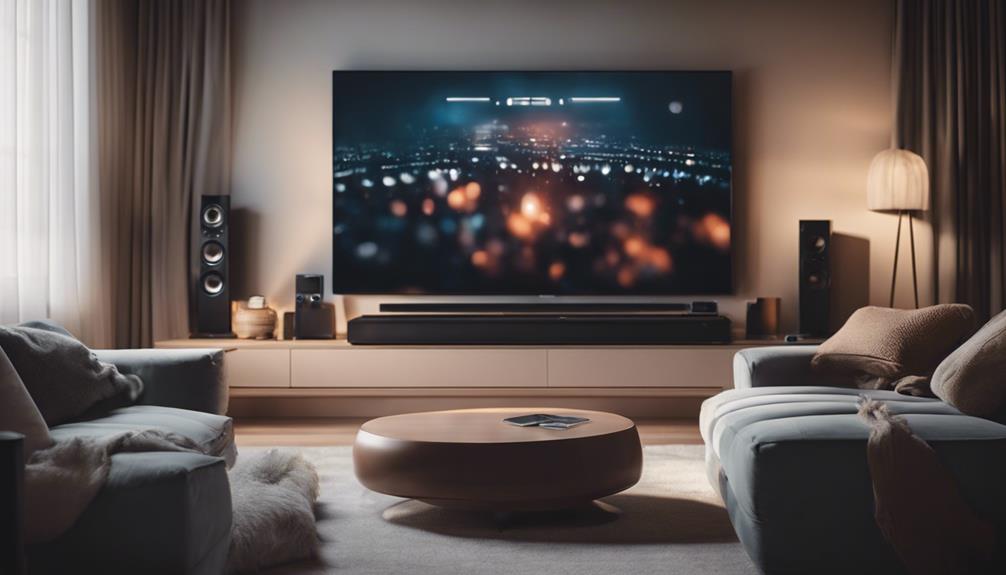
A great sound system can transform your home theater experience, providing immersive audio that brings movies and music to life. If you're on a budget, a modern soundbar is an excellent choice. These devices can simulate surround sound and support advanced audio formats like Dolby Atmos and DTS:X, all at a fraction of the cost of traditional surround systems. For instance, Vizio's M-series offers fantastic sound quality for under $500.
If you're looking for something more thorough, consider starting with bookshelf speakers like the ELAC Debut 2.0 B6.2, which costs around $340. Pairing these with a subwoofer will enhance your bass response, giving you that deep, rich sound.
Alternatively, for a complete budget-friendly setup, check out the TCL Q Class 5.1 Channel system, which includes a soundbar, subwoofer, and surround speakers for about $249.
Investing in a quality subwoofer can greatly enhance your audio experience, but if you're aiming to keep costs down, focus on options that fit your budget while still delivering impressive sound. With these choices, you can enjoy a enthralling home theater without breaking the bank.
Essential Audio Components
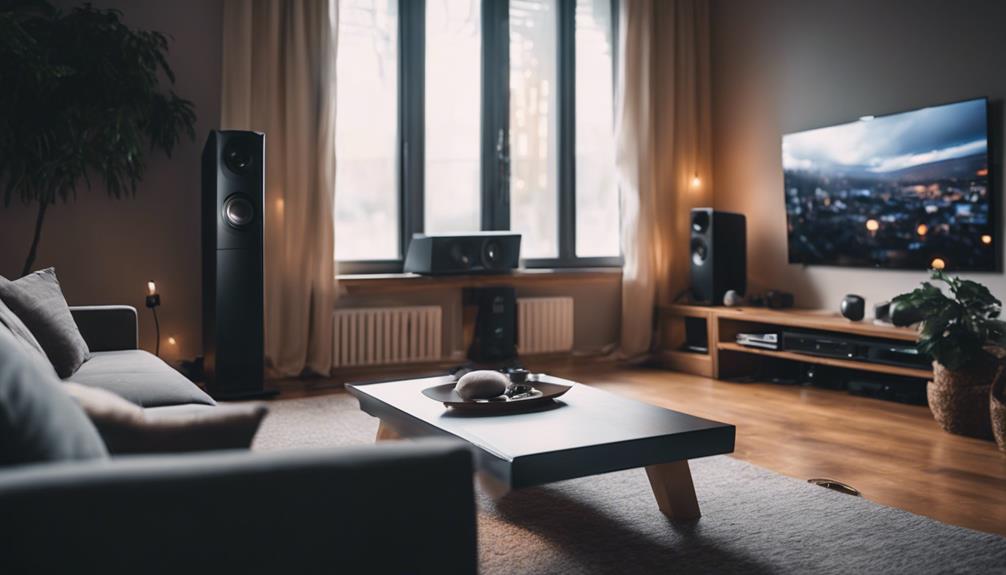
When setting up your home theater, choosing quality speakers is essential for great sound.
You'll also want to take into account ideal speaker placement to maximize audio performance and create an immersive experience.
Fortunately, there are plenty of cost-effective sound solutions that won't break the bank while still enhancing your setup.
Choosing Quality Speakers
Quality speakers are vital for creating an immersive home theater experience, enhancing everything from dialogue clarity to the depth of sound.
When choosing speakers for your surround sound system, consider the following tips to guarantee you're making a smart investment:
- Start with Bookshelf Speakers: Look into quality bookshelf speakers like the ELAC Debut 2.0 B6.2, which offers great sound clarity for around $340.
- Add a Center Channel: A center channel speaker, such as the ELAC C6.2 at $280, is essential for clear dialogue, making sure you don't miss a word during intense scenes.
- Incorporate a Subwoofer: Boost your low-end performance with a matching subwoofer from the ELAC Debut 2.0 series, creating a richer audio experience.
- Consistent Sound Quality: Stick to speakers from the same brand or family to maintain tonal consistency and overall performance.
Optimal Speaker Placement
Ideal speaker placement is essential for achieving the best audio experience in your home theater setup.
Start by positioning the center channel speaker directly above or below your TV, ensuring it's at ear level. This placement guarantees clear dialogue during films and shows, making it easier to follow the storyline.
For front speakers, place them at ear level when seated and 6 to 8 feet apart to create a balanced soundstage.
When it comes to surround speakers, aim for slightly above ear level and at least 2 feet behind your listening position. This setup enhances immersion, pulling you deeper into the action.
If you're incorporating a subwoofer, consider placing it in a corner or along a wall to boost low frequencies. However, don't hesitate to experiment with its location for the best sound.
For those using Dolby Atmos, think about adding upward-firing or in-ceiling speakers above your listening area. This creates a three-dimensional audio experience, making your home theater feel more dynamic.
Cost-Effective Sound Solutions
Finding cost-effective sound solutions can greatly enhance your home theater experience without stretching your budget. With a few key components, you can achieve impressive audio without breaking the bank. Here are some affordable sound solutions to contemplate:
- Entry-Level Surround Sound Systems: Look for systems under $500 that provide decent audio quality and surround sound immersion.
- Modern Soundbars: Consider soundbars like Vizio's M-series, which can mimic multi-channel audio experiences and support formats like Dolby Atmos.
- Bookshelf Speakers: Invest in quality bookshelf speakers like the ELAC Debut 2.0 B6.2 for around $340. Pair them with a subwoofer from the same series for deeper bass.
- Center Channel Speaker: Don't overlook the importance of a center channel speaker for improved dialogue clarity, making your viewing experience more enjoyable.
Room Layout Considerations

When designing your home theater, choose a specific room that's both dark and soundproof to elevate your viewing experience.
Room layout considerations are vital for achieving that cinematic feel at home. Start by arranging your seating for maximum comfort and visibility. Position your seats approximately 1.5 to 2.5 times the diagonal size of your TV for ideal viewing distance.
To enhance audio quality, proper speaker placement is essential. Place front speakers at ear level when seated, and make sure the center channel is positioned either above or below the TV. This will provide a balanced sound experience, making dialogue clearer and music richer.
Consider incorporating acoustic panels to minimize sound reflections and improve overall acoustics. Soft furnishings like rugs and cushions can also help absorb sound, creating an immersive audio environment.
Don't forget to install blackout curtains to reduce ambient light and glare, enhancing picture quality during day viewing.
DIY Installation Tips

When you're setting up your home theater, careful planning can make all the difference.
You'll want to choose cost-effective equipment and use simple wiring techniques to keep everything organized.
With a bit of creativity and some DIY skills, you can create an impressive setup without breaking the bank.
Planning Your Space
Start by evaluating your available space and dimensions to determine the best layout for seating, TV, and speakers that guarantees clear sightlines and sound distribution. Proper planning your space can turn an ordinary room into an impressive home theater space while helping you save money.
Here are some DIY installation tips to take into account:
- Assess the Layout: Measure your room and sketch a plan. Verify the seating is positioned for ideal viewing, ideally at a distance of 1.5 to 2.5 times the screen size.
- Choose Comfortable Seating: Find budget-friendly seating options that fit your space. Arrange them to create a "sweet spot" for the best sound and picture experience.
- Soundproofing: Use DIY soundproofing techniques, like making acoustic panels from inexpensive materials, to enhance your sound quality.
- Lighting Control: Install blackout curtains or shades to block out ambient light, improving picture quality and creating a more immersive atmosphere.
Cost-Effective Equipment Choices
Finding cost-effective equipment choices is essential for creating a budget-friendly home theater that still delivers an impressive viewing and listening experience.
Start by investing in a TCL 65-inch Q6 QLED 4K TV for $499. This model strikes a perfect balance between quality and price, offering built-in Google TV for easy streaming.
Next, enhance your audio with the TCL Q Class 5.1 Channel sound system. For just $249, you get a soundbar, subwoofer, and surround speakers, greatly improving your audio over standard TV speakers.
Consider DIY soundproofing techniques to improve your room's acoustics without breaking the bank. You can easily create acoustic panels using affordable materials.
Don't overlook second-hand audio/video equipment. Shopping for gently used gear allows you to find quality components at reduced prices, helping you allocate more of your budget toward essentials like seating or decor.
Simple Wiring Techniques
To create a clean and efficient home theater setup, you'll want to map out your wiring layout before diving into the installation process. Proper planning not only enhances audio quality but also simplifies any future adjustments. Here are some simple wiring techniques to take into account:
- Use Color-Coded Cables: This helps you easily identify and organize your wiring, making troubleshooting a breeze.
- Plan Your Layout: Measure distances accurately to avoid excess cable length, which can lead to signal loss.
- Opt for In-Wall Rated Cables: This guarantees compliance with safety standards when running wires through walls, minimizing fire hazards and boosting aesthetics.
- Implement Cable Management Solutions: Use raceways or cable ties to keep your wires organized and prevent tangling, enhancing both the appearance and accessibility of your setup.
Additionally, label each cable at both ends with tags or markers. This simple step can save you time and frustration when you need to make adjustments in the future.
Enhancing Acoustics
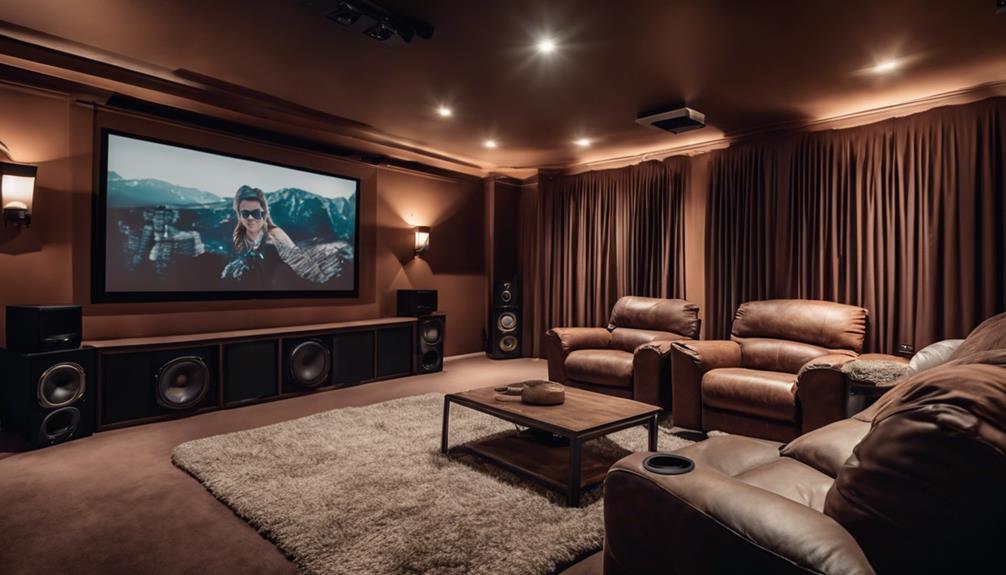
Enhancing acoustics in your home theater can transform your audio experience, making it more immersive and enjoyable. Start by incorporating sound-absorbing materials like thick area rugs and heavy curtains. These elements can considerably reduce sound reflections, helping to improve overall acoustics.
Consider creating your own DIY soundproofing panels using affordable materials such as foam or fabric-wrapped wood. These panels will enhance sound absorption and minimize echoes, ensuring you enjoy clearer audio.
Strategically arranging your furniture also plays an essential role. Try placing your seating away from walls and using bookcases as acoustic barriers to create a more immersive sound environment.
Moreover, investing in acoustic treatments like bass traps for corners and diffusers for flat surfaces can effectively manage low-frequency sounds without breaking the bank.
Don't forget to regularly test and adjust your speaker placement, especially if you're utilizing in-ceiling speakers for a Dolby Atmos setup. This practice will help optimize audio performance, ultimately creating a richer surround sound experience.
Smart Streaming Solutions
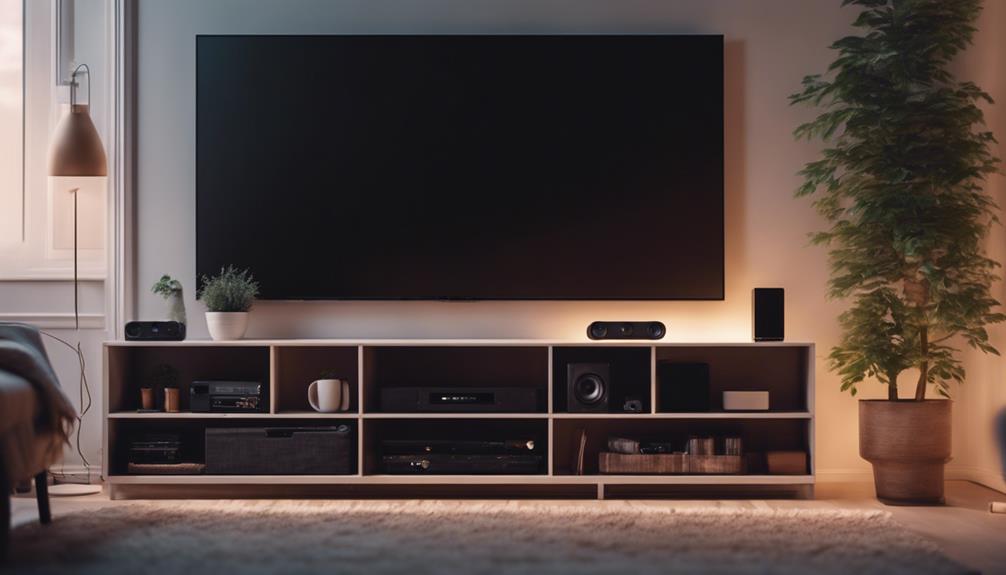
Improving your home theater acoustics sets the stage for a fantastic viewing experience, and incorporating smart streaming solutions can elevate your entertainment options even further.
These budget-friendly devices provide access to a vast array of content without emptying your wallet. Here are some great options to evaluate:
- Amazon Fire TV Stick: This device offers access to major streaming services for under $50, making it a fantastic addition.
- Roku Streaming: Many budget TVs come with built-in Roku platforms, simplifying your setup and saving you money on extra hardware.
- Roku Streambar Pro: Priced around $186.60, it combines a soundbar and streaming device, enhancing your audio while providing streaming access.
- Free Streaming Services: Explore platforms like Tubi or Pluto TV to expand your content library without incurring additional subscription fees.
Personalized Decor Ideas
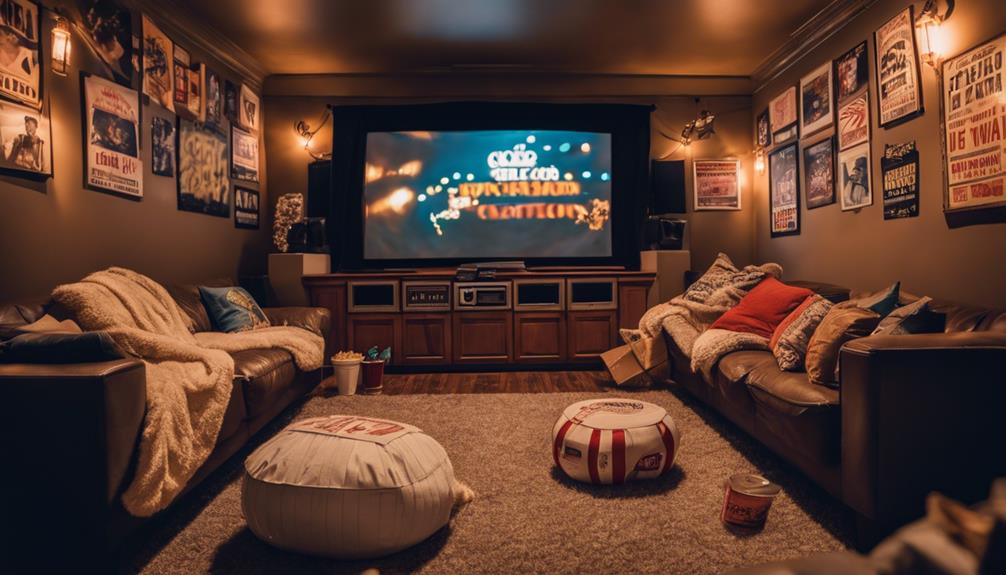
Creating a personalized decor scheme for your home theater can truly transform the space into a reflection of your unique style and interests.
Start by selecting themed decor elements, like movie posters or framed prints of your favorite films. This will help create a personalized ambiance that sets the mood for movie nights.
Next, consider incorporating LED strip lighting around your TV or shelves. Not only does this add a modern touch, but the color-changing options can enhance your viewing experience.
Comfortable seating is essential, so opt for bean bags or recliners arranged for ideal viewing angles. Adding decorative throw pillows can boost both style and comfort, making the space inviting.
To improve acoustics and reduce external noise, you might want to create DIY soundproofing panels using affordable materials like foam or fabric-wrapped insulation. This small effort can greatly enhance your home theater experience.
Maintenance and Upkeep
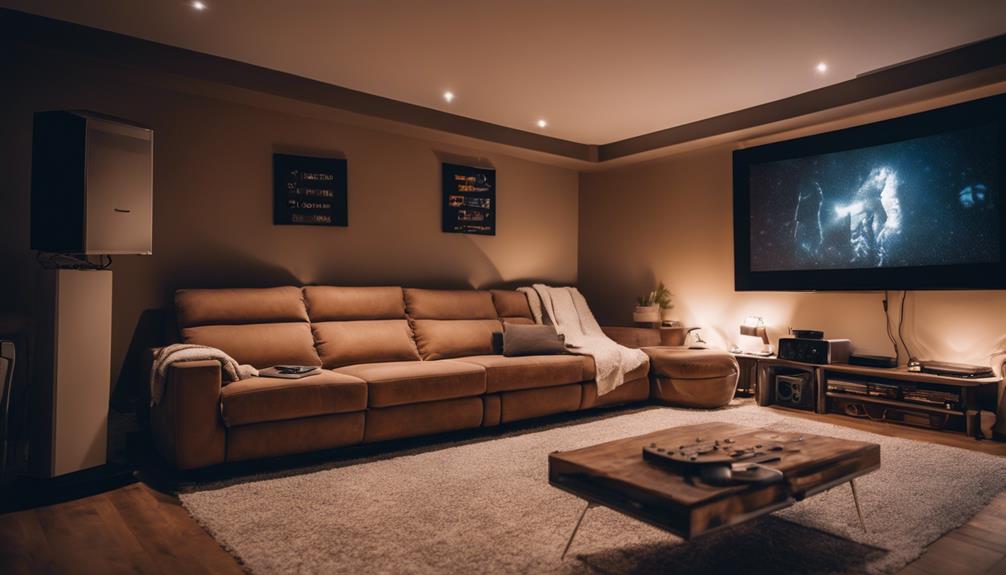
Regular maintenance is key to guaranteeing your home theater continues to deliver an exceptional viewing and listening experience. By incorporating a few simple habits into your routine, you can keep everything running smoothly and maintain the quality of your setup. Here are four essential maintenance tasks you should prioritize:
- Dust and Clean: Regularly dust and clean your audio/video equipment, including screens and speakers, to prevent performance issues due to dust buildup.
- Software Updates: Implement a schedule for software updates on your streaming devices and smart TVs. This guarantees peak functionality and access to the latest features.
- Check Connections: Every few months, check and tighten any loose cables and connections. Loose connections can lead to frustrating audio or video issues.
- Hygiene: Clean remote controls and frequently handled devices with disinfectant wipes to maintain hygiene, especially in shared spaces.
Additionally, periodically assess your audio settings and speaker placements to adapt to any changes in your room's acoustics.
Frequently Asked Questions
How to Set up a Budget Home Theater?
To set up a budget home theater, focus on essential components like a quality TV and sound system. Arrange seating for comfort, enhance acoustics, and consider DIY storage solutions to personalize your space while saving money.
How to Create a DIY Home Theater Setup?
To create a DIY home theater setup, choose a large screen TV and a decent sound system. Enhance acoustics with soundproofing panels, organize equipment with custom shelves, and add LED lighting for ambiance. Enjoy your cinematic experience!
How Much Does It Cost to Set up a Home Theatre?
Setting up a home theater typically costs between $630 and $2,000, depending on your choices. You can start with a budget-friendly TV and soundbar, then gradually upgrade for a better experience over time.
What Do I Need to Set up a Home Theater System?
Setting up a home theater system feels like creating a cinematic masterpiece in your living room! You'll need a quality display, immersive audio, an AV receiver, and optional speakers to enhance your audio experience.
Conclusion
By crafting your budget-friendly home theater, you're not just setting up a space; you're building a portal to endless entertainment.
With the right choices in technology and decor, you'll transform your living room into a cinematic oasis.
So, grab the popcorn and dim the lights—your personal film festival is just a click away.
Embrace the magic of movie nights and make every viewing an unforgettable adventure in your cozy haven!
Hello, I’m Art, and I’m excited to be a part of the 1Home Theatre Projector team. As a writer, I’m here to contribute my knowledge and insights to help you achieve the ultimate home cinema experience. I understand that making decisions in the world of home entertainment can be complex, and I’m here to simplify the process for you.
